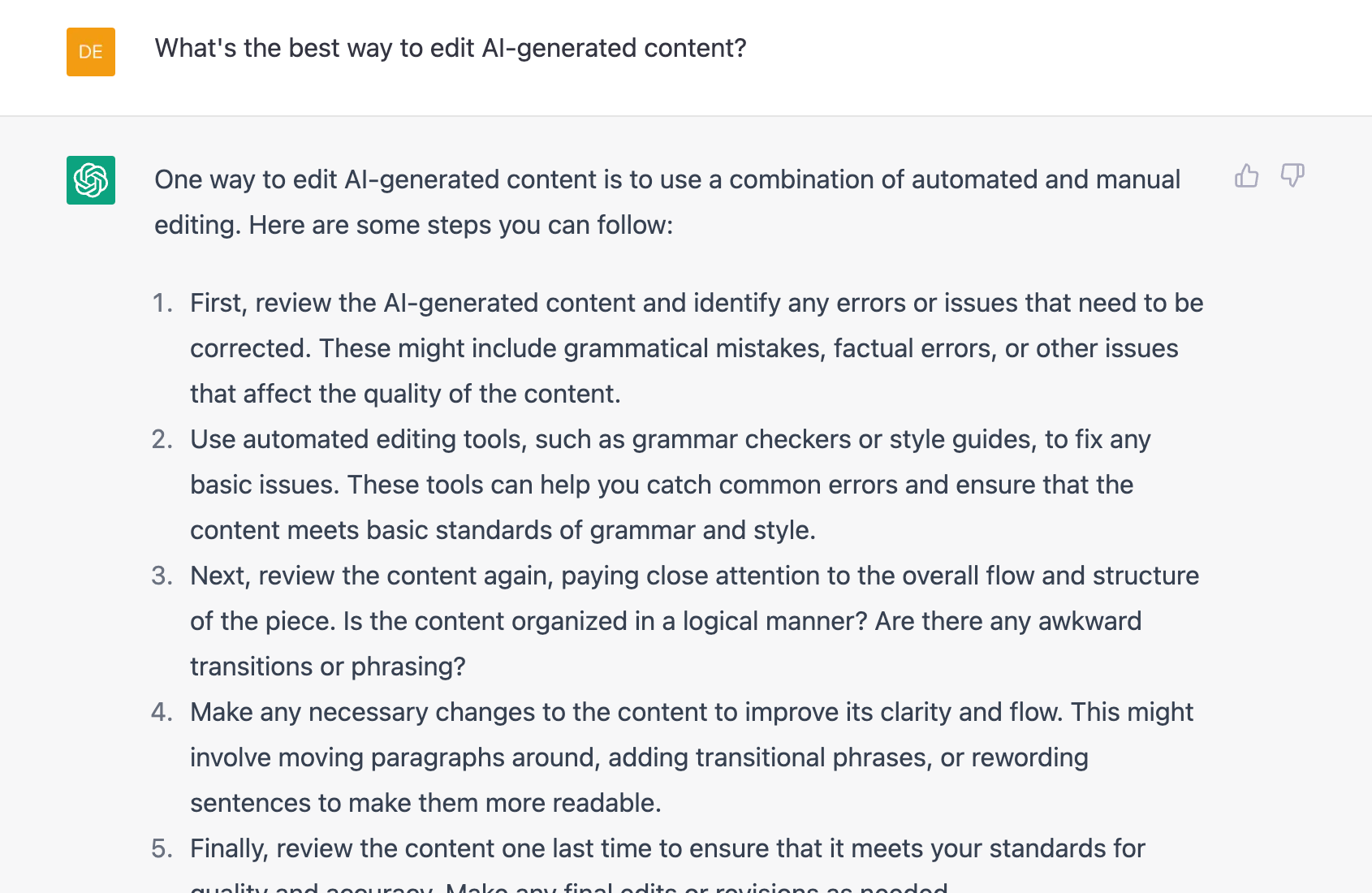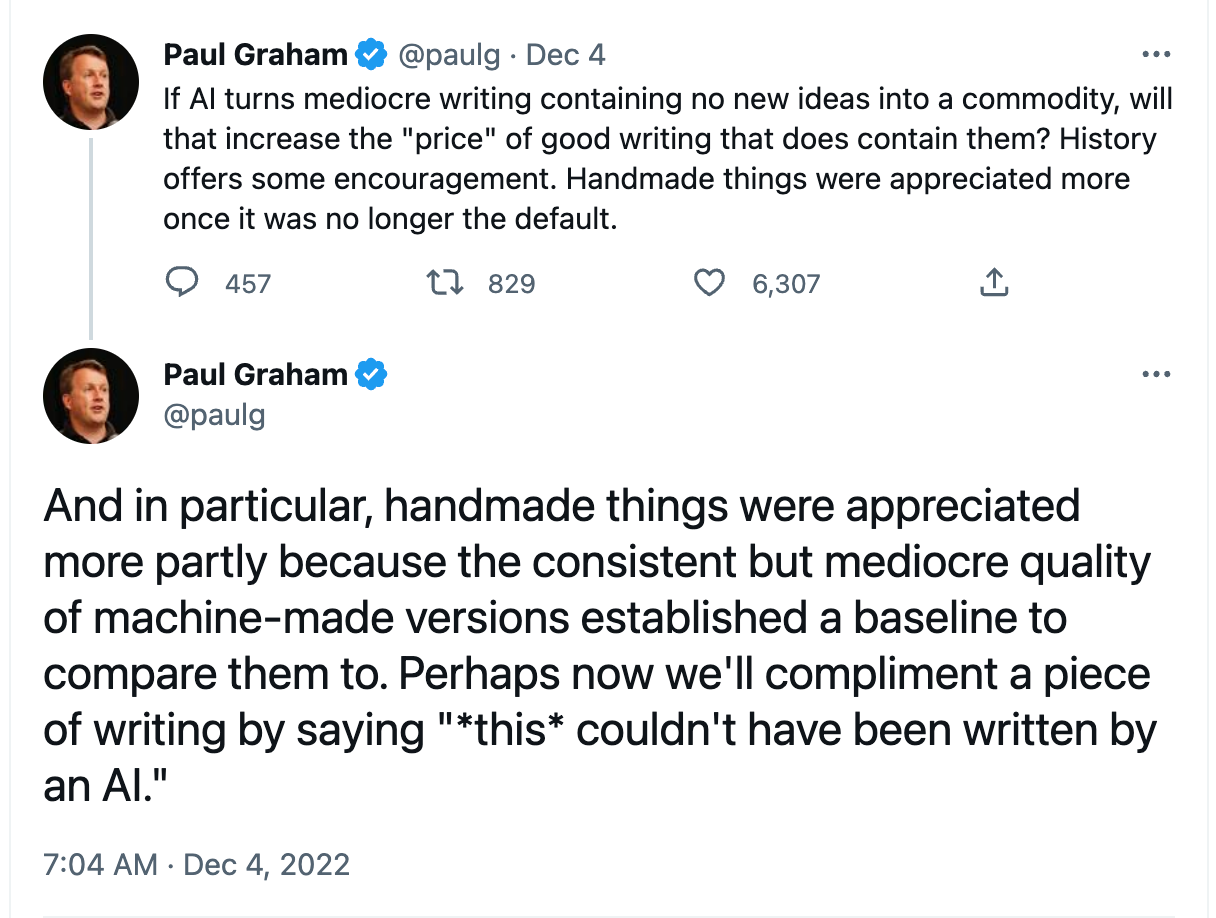This essay originally was published on June 16, 2023, with the email subject line "CT No.171: Zooming in on reader experience."
Ever since ChatGPT came along, questions about what it means to be human have all but inundated our digital spaces. As part of this mass obsession with generative AI, tech and marketing professionals of all stripes have become unusually preoccupied with content’s provenance rather than the impact that content has on readers.
The tech industry’s response to this obsession has been telling. Preparing to compete against ChatGPT and its integration with Bing, Google is gearing up to embed its experimental AI chat service Bard into its search engine. At the same time, more unscrupulous businesses whose only content strategy is to scale quantity without quality have started pumping out AI-generated content. For some, these developments could potentially lead to more noise and, you guessed it, fewer website visitors.
Quality reader experience may be our only saving grace. Mind you, I’m not talking about content performance here — although good performance should always be a byproduct of good reader experience. Without getting lost in an academic whirlwind of theories and hermeneutics, I’ll define reader experience as a subset of user experience (UX) that prioritizes giving readers access to content that’s both visually pleasing and intrinsically valuable. While UX is a broad term that encompasses improvements across the audience’s entire interaction with a product or brand, our recommendations here strictly apply to the reader: what qualities make content more readable?
When considering reader experience, remember that the building blocks of content discovery and optimization haven’t changed. High-quality backlinks, dwell time, engagement rate, and keywords still matter. What’s changing is how businesses approach content creation to maintain or improve marketing performance.
How to cultivate high-quality original content: Same building blocks, different structures
Embrace personalization
In a world where 71% of consumers expect personalization, and fast-growth companies drive 40% more of their revenue from personalization than their slower counterparts, it’s obvious that personalization matters. Research by Smarter HR even shows that 72% of consumers only engage with marketing messaging tailored to their interests. Meanwhile, hyper-personalization is one of the top five sales and marketing tactics used by B2B companies winning the most market share. So, if you’re not yet experimenting with personalization, it’s worth bumping it up on your priority list.
While marketers have used the term “personalization” liberally in the past few years to describe anything from inserting a person’s name in an email to producing targeted ads based on someone’s search history, those interpretations only scratch the surface when it comes to content personalization. In the context of reader experience, personalization means giving the reader content tailored to their specific needs and circumstances. (For the uninitiated, The Content Technologist has extensively written about personalization here, here, here, and here).
To be clear, personalization isn’t just about serving blog posts based on a person’s search history. Or segmenting your newsletter based on your audience’s age, gender, or location. Or sending someone an email based on their abandoned shopping cart. Instead, content personalization implies an intimate understanding of the audiences you cater to and creating quality, individualized content for each of them.
Harness in-house data to create original research
Quality content trumps everything else. In the past, linking back to reputable studies may have been enough to score clicks and views. But in the coming AI-powered digital landscape, you may need to invest in your own original research to achieve the same results.
For instance, in their B2B Content Marketing Benchmarks, Budgets, and Trends: Insights for 2023 report, the Content Marketing Institute (CMI) found that only 30% of B2B marketers created research reports in the last 12 months, even though they’re the third-best performing content asset, far surpassing long blog articles, videos (of any format), and infographics.
Compared to other tactics, research is also more likely to produce results that can be analyzed and applied to multiple business applications. In the United States, policymakers have a storied history of recognizing the economic benefits of research and development through tax incentives — meaning your research can sometimes pay for itself.
Of course, it’s not feasible to have every stat in your content come from original research, so focus on research that has strategic value to your audience. If you work in marketing, source your own marketing data. If you’re a retail SaaS business, use your first-party data as a case study to demonstrate how content affects retail performance. If your budget is limited, use what you already have at your disposal to create a proof-of-concept. Ask your customer success or support team for existing data on customer usage and transform that information into a small but nimble report.
Promote the report like you would any other content and keep an eye on lead quality and performance metrics. How many people downloaded the report? Do you have more websites linking back to the report? Have the dwell time or pages per session increased? If the report has quality data, human insights, and a compelling story, sharing just a few of your insights with your audience could lead to a demonstrable performance impact compared with other content, and potentially convince stakeholders to greenlight a bigger project.
If you have sufficient user data from subscribers and surveys, include those powerful insights in your original content. Go further and reach out to partners and external groups where your audience can be found and conduct statistically relevant surveys. If conducting a large-scale survey or study feels daunting, experiment at a smaller scale. Tap into your existing customer base to conduct user interviews or lead focus groups then present your findings in a distribution-ready case study, ebook, or white paper.
Use your team’s voice and insights to foster originality
Your colleagues represent a unique group of minds and abilities. They also likely have significant in-house knowledge that’s waiting to be shared with your audience. Instead of rehashing the same analogies and ideas, showcase the original, surprising and authentic experiences of your leadership team, internal directors, and managers. The insights and anecdotes they’ve collected over the years will outpace any bland “5 ways to” blog post.
If you’re starved for time, outsource this task to a professional ghostwriter or PR agency who can capture the voice of your team and produce high-quality content. I’ve certainly seen an increase for my ghostwriting services since the launch of ChatGPT. Industrywide, ghostwriting as a service is expected to become more prevalent, with a projected compound annual growth rate of 6.5% between 2021 and 2030.
Prioritize immersive digital storytelling
Personalization can be taken a step further by adjusting how the reader consumes content, not just how they receive it. When publishing your content, do you think about how the layout of the content influences experience? And do you consider that your brand’s favorite signature font may not be everyone else’s cup of tea?
Back in 2019, Microsoft launched their Immersive Reader, which was primarily aimed at people who experience visual impairments like dyslexia. Quickly recognizing its wider use case, the technology company made it freely available. Today, the reader is mostly promoted and used as a learning tool, but there’s no reason something similar can’t be applied in a broader context.
If your website is too bright or busy, you may be repelling perfect clients or customers, especially those who are neurodiverse or sensitive to visual information. These questions about accessibility can be eye-opening: Imagine what custom changes — like being able to adjust the color palette, customize the layout of the text, and even save those settings for their next visit to your site — can do for your dwell time and conversion rates.
While tools such as Helperbird already exist to allow users to adjust their reading experience on any website, they’re far from mainstream. They also put the onus on the user to improve their experience rather than the creator, which isn’t necessarily the best route for taking ownership of reader experience.
Aside from assistive technology, magazine-style features and tools that delight your readers can also make powerful statements, especially when their effects are organically embedded into your appeal. Tools like Ceros, ExCo, and Shorthand can create immersive feature landing pages to attract new audiences to brands whose websites are otherwise stuffy and business-like to the point of losing their human touch.
Christie’s, the influential British auction house, provides a compelling example. To showcase the meteorites available through their Deep Impact auction, the company subtly introduced an interactive parallax display on their website that explains how these space rocks ended up on Earth. As you keep scrolling, you can see asteroids impacting our planet, illustrating the rocks’s transformation into meteorites. The page ends with a beautiful 360-degree display of the meteorites they have on offer.
The point here is not to implement flashy features for the sake of being on-trend. It’s about how novel features can elevate your narrative, engage your audience, and strengthen your messaging. But just because novelty can be a powerful way to engage your audience doesn’t mean it’s suitable in every context. A 2018 study published in the International Journal on Advanced Science and Engineering found that parallax scrolling is great for storytelling websites (improves engagement) and online shops (helps visitors find items twice as fast). That said, an earlier 2015 study didn’t find a significant difference in performance between parallax and traditional websites. So, it’s up to you to discern where this feature can enhance or detract from reader experience.
Don’t forget to take your team along for the journey
It may be easy for content creators to think about reader experience. After all, creating content is their bread and butter. But getting the rest of your team up to speed may be a bit more challenging.
Depending on where your business is at in its digital journey, you may have a lot of work ahead of you. From updating your CMS to adjusting your content strategy, investing in major web development requires a long-term financial commitment. For that, you need your leadership team on board. So, how do you communicate the value and measurable returns these changes can bring about?
Bringing it all together: creating a more personalized approach to publishing online research
Let’s say you’re a customer support software vendor. You have customers of any size and from industries like retail, telecommunications, and education. You serve a global customer base, so they’d probably care more about trends and news in their region as opposed to a more generic overview of the industry. Now let’s say you want to publish a report on customer experience (CX) trends in 2023. How do you personalize such a broad topic, especially when catering to a diverse and global audience?
Zendesk has done just that with their latest CX Trends report. When I access the report, I’m greeted by my first name, which is a nice touch — and where most personalization ends. But Zendesk has added a nifty little Settings button that brings up a “Personalization” screen. There, I can select my industry, region, company size, and even the language of my personalized report.
Now, Zendesk doesn’t actually change the report itself, but it does provide segmented data based on my criteria in its infographic section and attach it to the bottom of my report.
Isn’t this the same as generating one comprehensive report with all the data available in one go? Yes, yes it is. However, giving your reader the ability to select only the content that’s relevant to them indicates that you’re aware of the information fatigue that we’re all suffering from and have a solution in mind. It also makes the reader more likely to stick around and actually read your report. Everybody wins.
One thing Zendesk doesn’t do here, though, is personalize the data throughout the rest of the report. In fact, even though I was asked about my industry, industry-specific data was not featured in the report — a considerable shortcoming given their overall effort towards personalization.
For teams smaller than Zendesk, the elephant in the room is, of course, the need for more content. Far more content than you may be able to produce. But this is a problem of mindset which you can solve relatively easily if you part ways with the idea that you need to publish X number of unique content pieces per month and focus your energy on publishing fewer thoroughly personalized pieces instead.
Good reader experience is memorable
At the end of the day, your content should give the individual members of your audience plenty of incentives to join an engaged, loyal readership. For that, you need content that excites and surprises, invites participation, and, above all, sticks to the mind.
If we borrow from Hans-Georg Gadamer’s wisdom, reader experience is something that goes beyond the fleeting and immediate and “leaves a lasting impression in memory.” Czech literary theorist Jan Mukařovský goes even further to say that the reading process is an interaction between the work and the reader where the reader’s “own reality is affected by his or her engagement with the work.”
So, next time you sit down to plan content, don’t compromise when crafting an indelible impression. Your readers, and your stakeholders, will thank you for it.
Natasha Serafimovska is a freelance writer with six years of industry experience in EdTech/SaaS, covering a number of tech verticals including emerging tech, unified comms, IoT and digital transformation. Natasha also works as an executive ghostwriter for Fortune 500 companies, and her work has been featured in TechCrunch, Entrepreneur, Newsweek, and more.
Hand-picked related content








